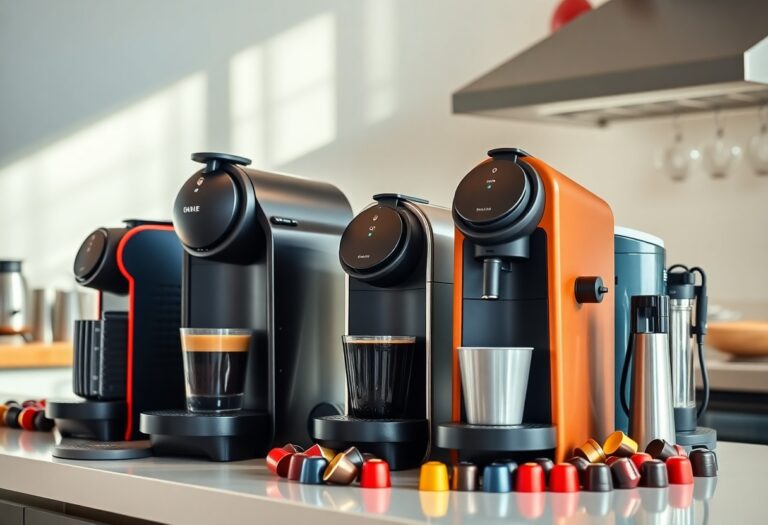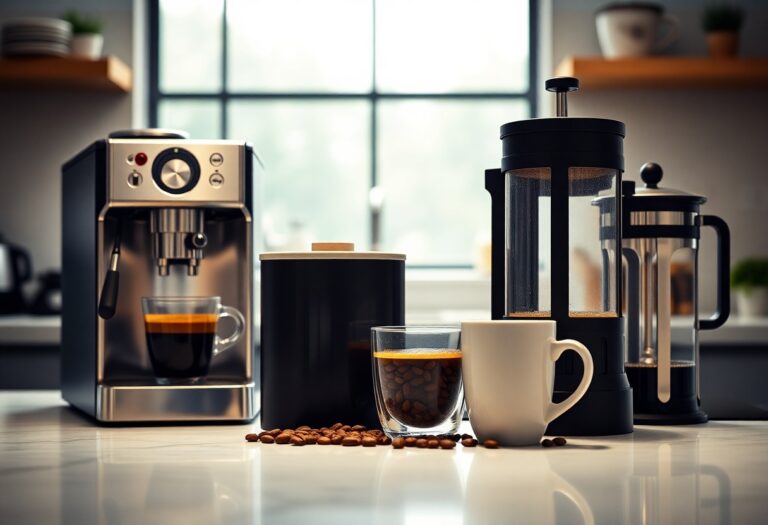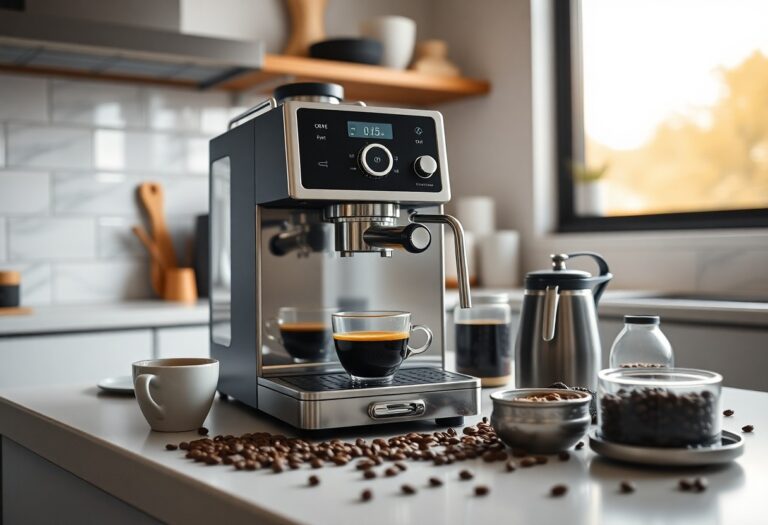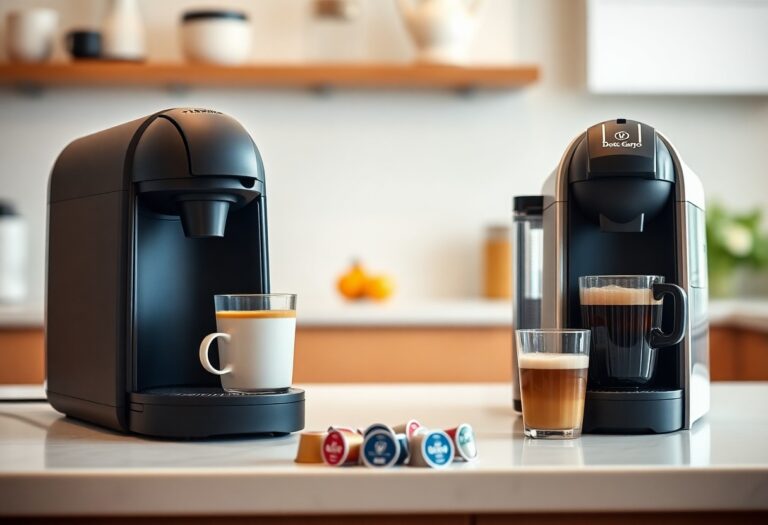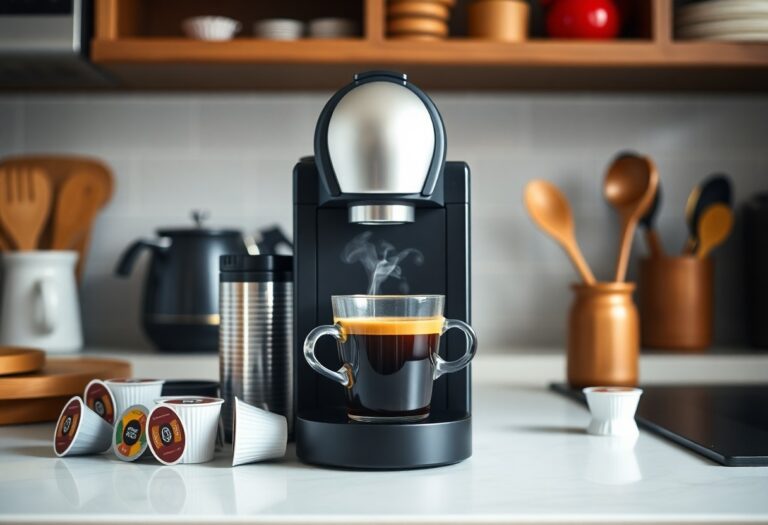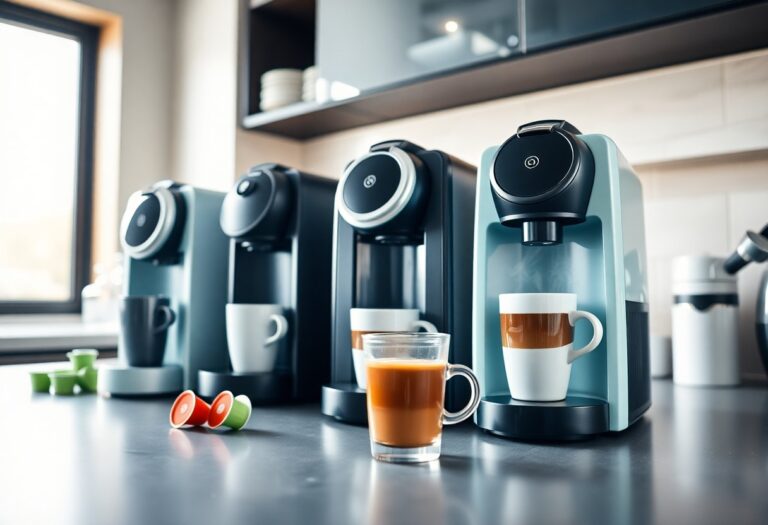What is the Difference Between Espresso Machine and Coffee Maker
With the rising popularity of coffee beverages, you might find yourself wondering about the distinction between an espresso machine and a coffee maker. While both devices serve the purpose of brewing coffee, they operate on different principles and produce vastly different results. Espresso machines use high pressure to force hot water through finely-ground coffee, creating a rich and concentrated shot, whereas coffee makers typically brew larger quantities of coffee using a drip method. Understanding these differences will help you decide which machine best suits your coffee preferences.
Key Takeaways:
- Espresso machines use high pressure to force hot water through finely ground coffee, resulting in a concentrated and rich flavor, while coffee makers typically brew coffee using gravity and a coarser grind.
- Espresso machines often come with advanced features like steam wands for frothing milk, making them more versatile for coffee beverages like lattes and cappuccinos compared to standard coffee makers.
- Preparation time varies; espresso machines can require a longer setup and cleaning time, whereas coffee makers usually have a more straightforward and quicker process.
- Cost can be a significant factor; espresso machines tend to be more expensive due to their complexity and additional features, while coffee makers are generally more budget-friendly.
- Serving size differs; espresso is typically served in small shots, while coffee makers produce larger quantities, making them suitable for serving multiple cups at once.
The Core Functionality of Each Brewing Method
Understanding the core functionality of espresso machines and coffee makers reveals the unique value each brings to your kitchen. Espresso machines are designed to create rich, concentrated shots of coffee by forcing hot water through finely-ground coffee at high pressure, while coffee makers provide a more straightforward approach, brewing light to medium-strength coffee by steeping coarsely ground coffee in hot water.
Espresso Machines: Crafting Rich Flavors Under Pressure
Espresso machines achieve their deep, vibrant flavors through a process known as espresso extraction. By applying high pressure, typically around 9 bars, they rapidly extract imperative oils and flavors from finely-ground coffee. This results in a small, concentrated shot of espresso, boasting a thick crema that enhances its rich, robust profile and satisfying mouthfeel.
Coffee Makers: Simplifying the Brew with Convenience
Coffee makers excel in their ability to simplify the brewing process, allowing you to prepare a satisfying cup of coffee with minimal effort. Most machines range from basic drip methods to advanced programmable models, enabling you to brew larger quantities—often up to 12 cups—at a time. With features like automatic shut-offs and built-in heating plates, you can enjoy your coffee hot and ready with just the push of a button.
Many coffee makers allow for customization as well, letting you adjust brewing strength and coffee-to-water ratios to suit your taste preferences. They often feature easy-to-use filters and carafes, making cleanup straightforward. The convenience of setting a timer means you can wake up to the aroma of freshly brewed coffee, showcasing how coffee makers are designed for both simplicity and daily practicality in your busy life.

The Mechanics of Extraction
The extraction process is central to how flavors are developed in coffee, whether using an espresso machine or a coffee maker. Espresso machines force hot water through finely-ground coffee at high pressure, extracting oils and flavors quickly. In contrast, coffee makers typically use gravity, allowing water to seep through coarsely ground coffee. This results in a more gradual flavor extraction. If you’re weighing the options, consider reading more about Coffee maker vs espresso machine: which one is best for ….
Pressure vs. Gravity: Different Approaches to Flavor
Espresso machines utilize high pressure during extraction, forcing water through the coffee grounds quickly, leading to a concentrated shot rich in flavor. This pressure allows for a unique balance of sweetness, acidity, and body, creating that signature crema atop espresso. Coffee makers using gravity, on the other hand, extract flavors more leisurely, resulting in a smoother cup of coffee but often lacking the intense complexity found in espresso. The method you choose directly impacts the flavor profile and richness of your brew.
How Brew Time Affects Extraction Quality
The duration of the brewing process is key to achieving optimal flavor extraction. In espresso, brewing typically happens within 25-30 seconds, allowing for a quick release of flavors. Conversely, coffee makers may take several minutes to complete the brewing cycle. This longer brewing time can lead to over-extraction, causing bitter notes to dominate the cup. Ideally, you want to balance brew time for your specific method to ensure flavors are fully developed without compromising on taste.
For espresso, the short brew time ensures that only the desirable flavors are extracted before undesirable compounds are released. A shot pulled too quickly might taste sour, while one that is over-extracted may present bitterness. With coffee makers, if you brew for too long, you risk pulling out excessive bitterness from the grounds. Aim for optimal brew times specific to your method to enhance your coffee experience effectively. Understanding these nuances allows you to master your brewing choices and enjoy the perfect cup tailored to your preference.
Taste and Texture: A Comparative Analysis
| Espresso | Coffee |
|---|---|
| Rich, bold, and complex flavor with a thicker texture. | Smoother, more diverse flavors with a lighter body. |
| Typically served in smaller doses (1-2 oz). | Often prepared in larger volumes (8-12 oz). |
| Features a creamy layer of crema on top. | Usually lacks a significant crema. |
Espresso’s Bold Profile vs. Coffee’s Versatility
Espresso boasts an intense and rich flavor profile, driven by a higher concentration of oils and soluble compounds due to its high-pressure brewing. In contrast, traditional coffee offers greater versatility in flavor, allowing you to experiment with various brewing methods, bean types, and flavor profiles to suit your mood or meal pairings.
The Role of Grind Size in Flavor Character
Grind size significantly impacts the flavor profile of both espresso and coffee. For espresso, a fine grind is imperative to facilitate quick extraction under high pressure, leading to its characteristic boldness. Conversely, coarser grinds in traditional coffee brewing allow for longer extraction times without over-extraction, resulting in a smoother, well-rounded taste.
The role of grind size is pivotal in unlocking the unique flavor characteristics of your brew. For espresso, the fine grind creates more surface area, enabling quick extraction in just 25-30 seconds, leading to a concentrated flavor with pronounced notes. If your grind is too coarse, you risk an under-extracted, sour brew. In traditional coffee, a coarser grind prevents over-extraction during longer brew times, which can produce a bitter taste. Understanding the ideal grind size for your chosen brewing method ensures you savor the full spectrum of flavors from your beans.
The Investment Factor: Cost and Value
Value in your coffee journey goes beyond the initial purchase price, encompassing long-term costs and the benefits each machine brings to your daily routine. While you may find espresso machines to be relatively more expensive, consider their potential to enhance your coffee experience. The long-term value comes from what you gain in flavor, quality, and satisfaction when brewing at home.
Initial Purchase Prices: What to Expect
Initial purchase prices vary significantly between espresso machines and coffee makers. You can expect an entry-level coffee maker to start around $20 to $50, while a decent espresso machine typically begins at around $100 to $300. Higher-end models can exceed $2,000, especially when equipped with advanced features and capabilities, reflecting not just the brand but the brewing potential.
Long-term Maintenance and Supplies Comparison
The long-term costs associated with espresso machines and coffee makers largely depend on the necessary supplies and maintenance. In the table below, you can see how each option compares in terms of recurring expenses.
| Item | Coffee Maker |
|---|---|
| Filters (Yearly) | $10 – $30 |
| Coffee Grounds (Yearly) | $100 – $200 |
| Cleaning Supplies | $10 – $30 |
| Repairs (Optional) | $0 – $50 |
| Maintenance Costs (Yearly) | $20 – $60 |
| Espresso Machine | $50 – $100 |
| Coffee Grounds (Yearly) | $150 – $300 |
| Cleaning Supplies | $20 – $50 |
| Repairs (Optional) | $50 – $150 |
| Maintenance Costs (Yearly) | $60 – $150 |
While espresso machines often come with higher ongoing maintenance expenses due to more complex mechanisms and higher quality coffee beans, they typically yield a more gourmet experience. You may find yourself investing in various coffee types, milk frothers, and even specialized cleaning kits, which, though costly, enhance your craft in making espresso-based drinks. Balancing your love for espresso with your budget will help you make the most informed choice.

User Experience: Who Wins in Usability?
Your experience with coffee-making machines heavily influences your daily routine. Espresso machines often involve intricate brewing processes, requiring multiple steps and attention to detail. On the other hand, standard coffee makers are user-friendly and designed for straightforward operations. With the push of a button, they can brew a pot of coffee without the need for extensive knowledge or skill. While espresso aficionados enjoy the craft of extracting perfect shots, those seeking simplicity might lean heavily toward traditional coffee makers.
Learning Curve: The Challenge of Mastering Espresso
Mastering an espresso machine can be a rewarding yet demanding journey. Achieving the perfect shot requires understanding grind size, tamping pressure, and extraction time, which can take time to learn. Each variable affects the resulting flavor profile, and even small adjustments can lead to drastically different outcomes. For enthusiasts eager to investigate into this world, the challenge is part of the allure, elevating your coffee experience to new heights of sophistication.
Convenience and Speed of Standard Coffee Makers
Standard coffee makers excel in convenience and speed, catering to busy lifestyles. With features like programmable settings, you can wake up to the enticing aroma of freshly brewed coffee, thanks to a scheduled brew time. Most models can produce a full carafe in as little as 5 to 10 minutes, making it easy to settle in with your favorite mug. Moreover, the simplicity of just adding water and ground coffee means you can quickly share a pot with family or guests, upholding social connections while enjoying your caffeine fix.
The efficiency of standard coffee makers reduces morning stress significantly, and you don’t need to be a coffee expert to enjoy a satisfying cup of joe. Many models include additional features like auto shut-off for safety and built-in water filters for enhanced taste. This combination of user-friendly operation and quick brewing times ensures that you can enjoy your preferred brew without spending too much time or energy, making them a favorite for many households.
To wrap up
Ultimately, the difference between an espresso machine and a coffee maker lies in their brewing methods and the type of coffee you wish to enjoy. Espresso machines use high pressure to extract a concentrated shot of coffee, perfect for rich flavors and crema, while coffee makers generally brew larger quantities of drip coffee at a lower temperature. Understanding these distinctions allows you to choose the right equipment based on your personal preferences and brewing style, enhancing your overall coffee experience.
FAQ
Q: What is the primary difference between an espresso machine and a coffee maker?
A: The main difference lies in the brewing method and the result produced. An espresso machine forces hot water through finely-ground coffee at high pressure, resulting in a concentrated shot of espresso with rich flavor and crema. A coffee maker, on the other hand, typically uses drip brewing — hot water cascades through coffee grounds and drips into a carafe, producing a milder cup of coffee.
Q: Can espresso machines also make regular coffee?
A: Some espresso machines come with multi-function capabilities and can brew regular coffee as well. However, traditional espresso machines are primarily designed for espresso shots. To brew regular coffee, you would typically need a dedicated coffee maker or a specific espresso machine that includes a drip brew function.
Q: Does the quality of coffee differ when using an espresso machine versus a coffee maker?
A: Yes, the quality of coffee can differ significantly. Espresso machines typically use finely-ground coffee and high pressure to extract flavors efficiently, resulting in a stronger and richer taste. Coffee makers generally use coarser coffee grounds and a longer brew time, leading to a lighter flavor profile. The choice between them will depend on personal taste preferences.
Q: Are espresso machines more expensive than coffee makers?
A: Generally, yes. Espresso machines tend to be more expensive than standard coffee makers due to their complex design and advanced technology required to create the high pressure necessary for brewing espresso. However, there are also budget-friendly options available for both types, depending on the features and brands you choose. Investing in an espresso machine often correlates with the quality of the espresso produced.
Q: Which one is easier to use for beginners, an espresso machine or a coffee maker?
A: For beginners, a traditional coffee maker is usually easier to use. It typically involves adding water and coffee grounds, then pressing a button to start brewing. Espresso machines can require more technique and practice, such as tamping the coffee grounds properly and adjusting water pressure, making them more challenging for new users. However, many modern espresso machines have user-friendly features that simplify the brewing process.


